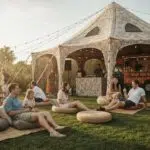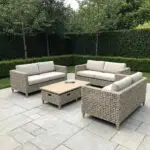Achieving perfect tent ventilation and precise climate control is key to ensuring your Southern California events are comfortable and memorable for every guest. Understanding how cooling, airflow, and humidity management work together allows you to sidestep issues like overheating, stuffy air, and bothersome condensation. This guide offers essential tent ventilation tips for events, covering portable air conditioning options, evaporative and misting technologies, smart fan placement, dehumidification techniques, safe heating solutions, and planning calculations. You’ll discover how each method functions, why it’s important, and how to pick the ideal equipment for your tent size, guest numbers, and local climate.
How Do Tent Cooling Solutions Elevate Guest Comfort at Events?
Tent cooling solutions fine-tune temperature and air circulation by removing excess heat and introducing conditioned air, which significantly reduces thermal stress and boosts overall guest satisfaction. Effective cooling combats fatigue, supports food safety standards, and maintains a stable environment for your event’s décor and electronics. Implementing the right equipment creates a consistent climate that keeps attendees comfortable from the moment they arrive until they depart.
What Types of Portable Air Conditioning Units Are Ideal for Event Tents?

Portable air conditioning units provide focused cooling power, measured in BTUs (British Thermal Units), which dictates how quickly they can lower tent temperatures and maintain guest comfort. These units work by drawing in warm air, cooling it through refrigerant cycles, and then recirculating the conditioned air beneath the tent canopies.
| Unit Type | Cooling Power (BTU/h) | Best Suited Tent Size (sq ft) |
|---|---|---|
| Evaporative Coolers | 10,000 | 300–800 |
| Packaged Portable AC | 18,000 | 800–1,500 |
| Trailer-Mounted Chiller | 50,000 | 1,500+ |
Choosing a unit that matches your tent’s dimensions ensures efficient cooling without wasting energy or falling short, preparing your space perfectly for your guests.
How Do Evaporative Coolers and Misting Fans Enhance Tent Airflow?
Evaporative coolers and misting fans improve airflow by introducing cool, moisture-rich air that effectively pushes out hot, stagnant air pockets.
- Evaporative coolers leverage water evaporation to lower incoming air temperatures by as much as 20 °F.
- Misting fans combine strong airflow with fine water mists for targeted cooling.
- Both technologies use less energy than traditional AC units in drier conditions.
By optimizing airflow patterns, these systems ensure a constant exchange of fresh air, laying the groundwork for successful ventilation strategies.
How to Select Tent Cooling Equipment Based on Tent Size and the Southern California Climate?
Choosing the right cooling equipment means matching its capacity (BTU/h) to the tent’s volume and considering regional humidity levels. In coastal areas with moderate humidity, packaged AC units offer reliable cooling, while inland desert regions benefit most from evaporative coolers paired with misting fans. Always calculate cooling needs at one ton of cooling per 100 sq ft for enclosed tents, and increase this for tents with clear tops or plastic walls.
What Are the Top Practices for Effective Tent Ventilation and Airflow?
Proper tent ventilation works by expelling hot air from the tent peaks and drawing in cooler outside air, which balances pressure and prevents heat buildup. Incorporating open sidewalls, roof vents, and exhaust systems guarantees continuous natural or mechanical airflow. Achieving effective cross-ventilation, strategic fan placement, and humidity control maintains fresh, breathable air, ensuring guest comfort and event safety.
How Does Cross-Ventilation Function in Large Event Tents?

Cross-ventilation harnesses wind direction by placing intake openings on the side facing the wind and exhaust vents on the opposite side. Incoming air naturally pushes warmer interior air toward the exits, creating a continuous flow that evenly cools the entire space. This passive approach works exceptionally well with low-profile ridge vents to enhance the stack effect and reduce the need for powered systems.
Where Should Fans and Air Movers Be Positioned for Optimal Air Circulation?
Placing fans and air movers at tent corners and along sidewalls encourages circular airflow patterns that sweep cool air across guest areas and guide stale air toward exhaust points.
- Position high-capacity floor fans near entrances to draw fresh air inside.
- Mount air movers at mid-height to generate swirling circulation.
- Direct axial fans toward tent peaks to help expel rising warm air.
Strategic equipment placement prevents uncomfortable hot spots and prepares the environment for effective humidity control measures.
How Can Natural Ventilation Effectively Reduce Humidity and Improve Air Quality?
Natural ventilation lowers humidity by exchanging moist indoor air with drier outdoor air, particularly effective during late afternoons and early evenings when coastal breezes typically strengthen. Opening tent sidewalls, utilizing mesh panels, and aligning tents with prevailing winds all contribute to reduced moisture levels and a healthier atmosphere for your guests. This process primes the tent for any supplemental dehumidification strategies.
How Can Humidity Control and Condensation Prevention Maximize Guest Comfort?
Effectively managing humidity in event tents prevents condensation on surfaces, discourages mold growth, and maintains crisp, clean air quality. Successful moisture control depends on using dehumidifiers, selecting breathable tent fabrics, and choosing event sites that avoid water accumulation. Neutralizing excess moisture safeguards décor, electronics, and guest well-being while preserving the comfortable atmosphere created by proper ventilation.
Why Are Dehumidifiers Crucial for Event Tent Climate Control?
Dehumidifiers actively remove ambient moisture, lowering relative humidity to below 50 percent, which prevents dripping condensation and that clammy feeling. These units condense water internally and release dry air back into the tent, boosting cooling efficiency and stabilizing interior conditions—essential for evening events or coastal gatherings where humidity levels tend to be higher.
What Tent Materials and Site Selection Strategies Help Prevent Moisture Build-Up?
Opting for breathable fabrics like polyester blends and installing ground tarps or elevated flooring prevents moisture from migrating up from the soil. Selecting sloped or well-drained locations avoids puddles forming beneath the tent. These material and site choices work hand-in-hand with dehumidification to keep flooring and lower tent walls dry.
How Does Proper Ventilation Prevent Condensation in Wedding and Corporate Tents?
By ensuring continuous airflow through vents and exhaust fans, warm, moist air is prevented from accumulating on cooler surfaces, stopping water droplets from forming. Keeping sidewall openings and roof vents clear allows for essential air exchange that combats dew formation, preserving pristine linens and glassware for your formal events.
What Are Safe and Effective Heating Options for Event Tents?
Tent heating solutions extend your event season into the cooler months by raising interior temperatures through convection or radiant heat. Propane and electric radiant systems provide warmth without cumbersome ductwork, while forced-air heaters circulate conditioned air via duct runs. Strict safety protocols and adequate exhaust ventilation are paramount to prevent carbon monoxide buildup and maintain safe oxygen levels.
How Do Propane and Radiant Heaters Operate Safely in Tented Venues?
Propane heaters burn fuel to generate infrared heat that directly warms people and objects, rather than just the air. Radiant panels use electric elements to emit gentle heat waves. Both systems require specific clearances from flammable materials, adequate oxygen supply, and approved venting paths for combustion byproducts, ensuring safe operation throughout your event.
| Heater Type | Heat Delivery Method | Ventilation Requirement | Ideal Application |
|---|---|---|---|
| Propane Radiant | Infrared waves | Open vents, 2 sq ft per lb of fuel | Outdoor festival tents |
| Electric Panel | Radiant panels | Minimal; adhere to manufacturer guidelines | Wedding lounges |
Selecting and positioning heaters safely ensures your guests stay warm without compromising air quality.
What Ventilation Is Necessary When Using Forced-Air Tent Heaters?
Forced-air heaters draw in ambient air, heat it using a heat exchanger, and then distribute it through insulated ducts. They require both fresh-air intake ports and exhaust vents to prevent oxygen depletion. Position the intake near ground level and the exhaust near the roof ridge, ensuring balanced pressure and consistent warm air distribution.
How Should Event Planners Assess and Plan Tent Climate Control Needs?
Accurately assessing climate control requirements starts with calculating the total BTU and CFM (cubic feet per minute) needed, based on tent volume, anticipated guest count, and peak outdoor temperatures. Planners then map out equipment placement, confirm power availability, and establish safety margins. A well-structured plan prevents under- or over-specifying equipment, optimizing both costs and performance.
How to Calculate Cooling and Heating Requirements Using BTU and CFM?
Multiply the tent’s floor area by its ceiling height to determine the volume, then apply one ton of cooling (12,000 BTU) for every 100 sq ft. To calculate CFM, divide the required BTU by 1.08 multiplied by the desired temperature difference (ΔT in °F) to find the necessary airflow. These formulas provide precise equipment sizing that aligns with your guest comfort goals.
What Are Key Installation and Safety Guidelines for Tent Climate Equipment?
Ensure all units are placed on stable, level surfaces and maintain manufacturer-recommended clearances from walls and décor. Use GFCI-protected power sources, secure all wiring within conduit or cable ramps, and test emergency shut-off features. Install carbon monoxide and smoke detectors near heating systems to ensure attendee safety.
How Does Southern California’s Climate Influence Tent Climate Control Choices?
Southern California features diverse microclimates, ranging from cool coastal breezes to intense inland desert heat. Coastal events might require dehumidification and moderate cooling, while desert locations demand high-capacity evaporative or refrigerant-based AC systems, ideally paired with shade canopies. Understanding these local weather patterns is key to selecting the most effective tent ventilation and equipment.
Final Thoughts
By implementing strategies such as selecting the right cooling units, optimizing airflow, managing moisture effectively, ensuring safe heating, and conducting thorough planning, event planners can provide exceptional guest comfort and seamless operations while highlighting the expertise behind Ventura Rental’s comprehensive climate control solutions.






